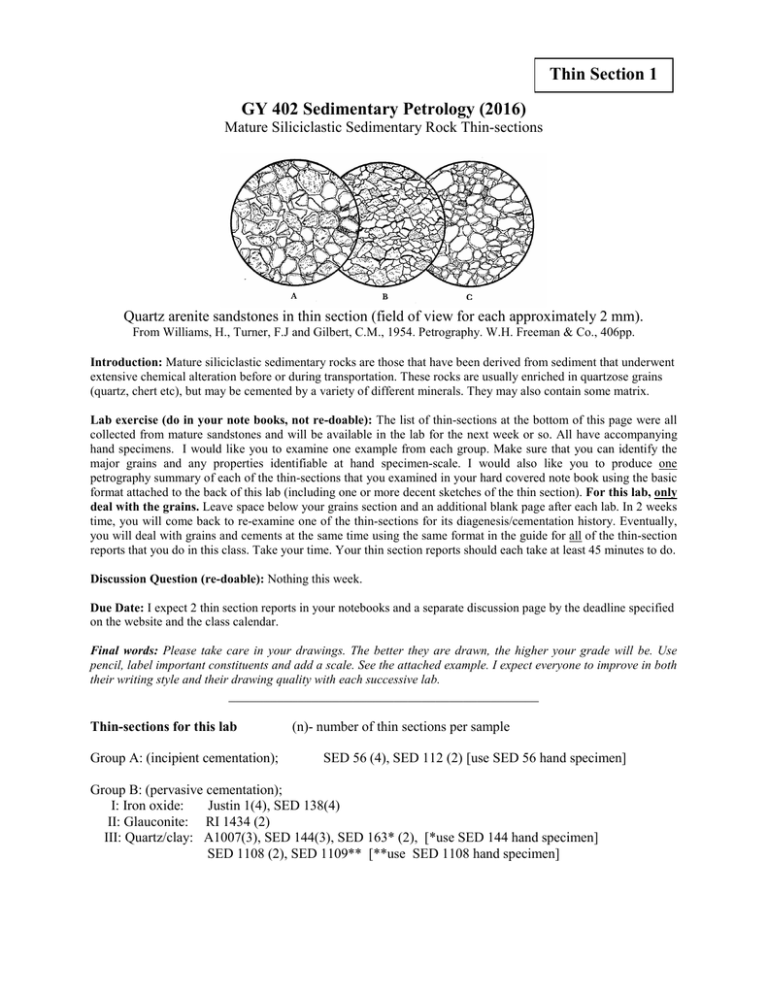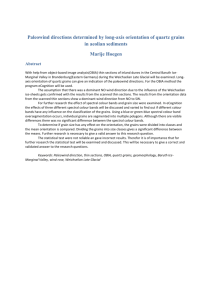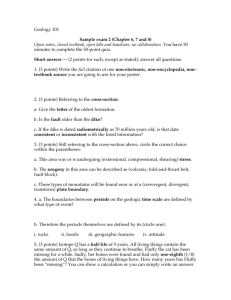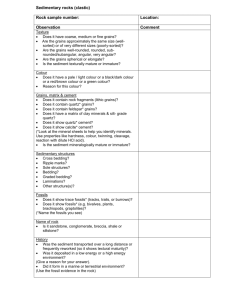Thin Section 1 GY 402 Sedimentary Petrology (2016)
advertisement

Thin Section 1 GY 402 Sedimentary Petrology (2016) Mature Siliciclastic Sedimentary Rock Thin-sections Quartz arenite sandstones in thin section (field of view for each approximately 2 mm). From Williams, H., Turner, F.J and Gilbert, C.M., 1954. Petrography. W.H. Freeman & Co., 406pp. Introduction: Mature siliciclastic sedimentary rocks are those that have been derived from sediment that underwent extensive chemical alteration before or during transportation. These rocks are usually enriched in quartzose grains (quartz, chert etc), but may be cemented by a variety of different minerals. They may also contain some matrix. Lab exercise (do in your note books, not re-doable): The list of thin-sections at the bottom of this page were all collected from mature sandstones and will be available in the lab for the next week or so. All have accompanying hand specimens. I would like you to examine one example from each group. Make sure that you can identify the major grains and any properties identifiable at hand specimen-scale. I would also like you to produce one petrography summary of each of the thin-sections that you examined in your hard covered note book using the basic format attached to the back of this lab (including one or more decent sketches of the thin section). For this lab, only deal with the grains. Leave space below your grains section and an additional blank page after each lab. In 2 weeks time, you will come back to re-examine one of the thin-sections for its diagenesis/cementation history. Eventually, you will deal with grains and cements at the same time using the same format in the guide for all of the thin-section reports that you do in this class. Take your time. Your thin section reports should each take at least 45 minutes to do. Discussion Question (re-doable): Nothing this week. Due Date: I expect 2 thin section reports in your notebooks and a separate discussion page by the deadline specified on the website and the class calendar. Final words: Please take care in your drawings. The better they are drawn, the higher your grade will be. Use pencil, label important constituents and add a scale. See the attached example. I expect everyone to improve in both their writing style and their drawing quality with each successive lab. _____________________________________________ Thin-sections for this lab Group A: (incipient cementation); (n)- number of thin sections per sample SED 56 (4), SED 112 (2) [use SED 56 hand specimen] Group B: (pervasive cementation); I: Iron oxide: Justin 1(4), SED 138(4) II: Glauconite: RI 1434 (2) III: Quartz/clay: A1007(3), SED 144(3), SED 163* (2), [*use SED 144 hand specimen] SED 1108 (2), SED 1109** [**use SED 1108 hand specimen] Example Notebook Format (Hand-written) October 2, 2005 Petrologist: Jane Doe Thin-Section Report 1 Immature Siliciclastic Sandstones Sample Number: MD 1234 Thin-Section Number: MD 1234 A: Rock Description. The sample is well cemented, gray-brown in color and highly fractured. It contains weak parallel laminations, carbonaceous (plant) remains and in situ rootlets. Grains are very fine to medium grained, well sorted, sub-angular and dominantly siliciclastic in composition. Dominant minerals include orthoclase, muscovite and quartz. The rock fizzes weakly with HCl suggesting that some of the matrix/cement is calcite. B: Thin-section Description. I) Grains Quartz Orthoclase Muscovite Plagioclase Rock frags (meta) Chert Opaque minerals unidentifiable 45% 10 4 3 2 2 tr tr Mean Grain Size: 125 to 500 μm Sorting: fair (0.7) Rounding: sub-angular (0.3) II) Intra-particular materials calcite cement Matrix Total 22% 8% 100% (crossed polars) QFR Normalization Calculations Q: 45% 45/62 x 100% = 72.6% F: 13 17/62 x 100% = 27.4% R: 4 45/62 x 100% = 6.4% 66% 100.1% Rock Name = Feldsarenite (Arkose) Example Writing Component (Typed on separate page) Discussion Question: Discuss the origin of the lithic grains in your thin section and describe any evidence of chemical alteration that might have occurred in the rock. Most of the lithic fragments in thin section RI 2323 are metamorphic in origin as indicated by the foliation that is apparent in many "schist" fragments. The ultimate source of the sediment was probably a metamorphosed continental suite of rocks as evidenced by the elongated or foliated nature of the clasts (see Figure 1 below. Figure 1: Sketch of a metamorphic rock fragment contained within thin section RI 2323. This sample contains a high percentage of immature grains (feldspar, muscovite) suggesting limited chemical weathering prior to transport and that the source of the sediment was probably fairly close to the eventual place of deposition. Many of the feldspar grains are "cloudy" indicating in situ chemical weathering to kaolinite (see Figure 2 below). This implies that the alteration process was incomplete prior to sedimentation. Figure 2: Sketch of kaolinite alteration in an orthoclase grain in thin section RI 2323. GY 402 Sedimentary Petrology Sedimentary Rock Classification (QFL) Ternary Plot (Folk, 1968) Field Index: 1 – Quartz Arenite 2 – Subfeldsarenite 3 – Sublitharenite 4- Feldsarenite (Arkose) 5 – Lithic Arkose 6 – Feldspathic Litharenite 7- Litharenite Comparison chart for estimating mineral percentages in thin-section (Not the best way to do this, but relatively fast). From Terry R.D. and Chiligar, G.V, 1955. Concerning some additional aids in studying sedimentary formations. Journal of Sedimentary Petrology, 25, 229-234. From Berkman, 1989. Field Geologists Manual, Australian Institute of Mining and Mineralogy, 382p.





